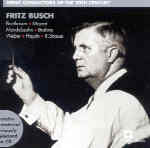These days Fritz Busch is little known outside the circles of the cognoscenti, and even there he’s sometimes confused with his brother, violinist/conductor Adolf Busch. Fritz is best known for his classic pre-war Glyndbourne Mozart opera recordings, made after he fled the Nazis in 1933 despite his “Aryan” credentials. By then he was already well established as an opera conductor and champion of his contemporaries from Berg to Hindemith and beyond. From 1934 until the end of his career, with the exception of the war years, he conducted the Danish State Radio Orchestra, building it into a respectable ensemble. This entry in EMI’s Great Conductors series doesn’t offer any music written after 1889, nor any examples of Busch as an opera conductor aside from a pair of overtures, but it does give a rounded view of his talents in the core Austro-German repertoire. All the items are in mono (he died in 1951) and except for a 1936 Strauss Don Juan with the London Philharmonic, all feature his postwar Danish orchestra.
Brahms is an important presence here, less for any lingering influence of Busch’s teacher, Fritz Steinbach, Brahms’ friend and leading conductor, than for the more objective, classical approach of Felix Weingartner, whose influence is more keenly felt in a 1947 Brahms Second and a 1950 Tragic Overture. Like Weingartner (and Toscanini), Busch’s Brahms features brisk tempos, clear textures, and firm rhythms, but these attributes are leavened by a warmth that sometimes eluded his models. Thus, the Danish strings are radiant in the first movement, the tart winds at the opening of the Andante grazioso lend a piquant flavor, and the driving last movement is rousing. Busch’s Adagio is noteworthy for its tenderness, even at a fluid tempo considerably faster than Bruno Walter’s reading of that movement with the New York Philharmonic in another Great Conductors volume.
Busch’s Mozart conducting is outstanding. His Adagio opening to Mozart’s “Linz” Symphony No. 36 is weighty–then he shifts gears to produce a fleet, very “classical” performance full of rhythmic life and a singing line. Once again, the Andante achieves warmth within a flowing tempo, the Menuetto is deliciously springy, and in the final movement Busch evokes nuanced phrasing in the brief solos, again within an energetic frame.
Haydn’s Sinfonia concertante, with oboe, bassoon, violin, and cello soloists, is charming, though the oboe’s quacking timbre doesn’t blend well with his smoother colleagues. Fine as this is, it can’t erase memories of Ormandy and the Philadelphia Orchestra’s crack first-desk soloists. In Mendelssohn’s Italian Symphony, Busch’s “objective”, northern approach softens to flood the work with Mediterranean sunlight. The bright phrasing of the initial theme is well-nigh perfect, there are plenty of expressive touches–such as the way Busch points up the walking rhythm in the Andante–and he gets the strings to put a smile in their tone in the witty Saltorello of the final movement. This is Mendelssohn on vacation, and Busch takes us with him, the sun only momentarily obscured by the clouds of those acidic Danish winds at the start of the Andante.
The 1950 Mendelssohn is live, as are the Beethoven Leonore Overture No. 2 from the same concert and the splendid Brahms Tragic Overture from a few months later. The energy level of the Beethoven is high, and Busch’s opening creates an expectant mood while his wide dynamic range enhances the drama, capped by the trumpet’s call and whirlwind finale. Weber’s Freischütz Overture is another dramatic reading but suffers from constricted sound, the least appealing on the set despite its relatively late 1950 date.
The earliest recording here is Busch’s 1936 London Don Juan, but the sound is more than adequate to give a good idea of the performance and of Busch’s intentions. Despite tubby bass and the inevitable dynamic narrowing imposed by the equipment of that era, it’s surprisingly rich-sounding, and Busch’s performance is downright terrific, with sparkling strings and vivacious high spirits, along with a middle section that’s one of the more seductive on disc–this is a Don who can sweet-talk with the best of them. So while this set doesn’t give you the whole picture of Busch’s career, it’s a welcome reminder of what a fine conductor he was, and several of the performances should be heard by anyone with an interest in these composers or in the art of conducting.
































